|
|

|
1 game board
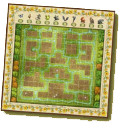
|
4 player boards

|
|
55 dominoes
-
each domino shows 2 animals
-
there are 10 different animals in the game
-
each combination exists once
|

|
|
74 plants
-
there are 4 types of plant:
turf, bush, pine, oak
-
each type comes in 5 colors:
the four player colors and
one neutral color
|
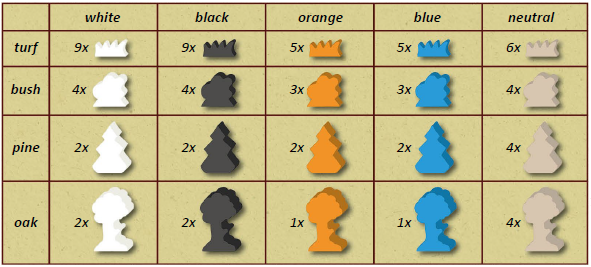
|
|
21 area tokens
|
front
back
|

|
|
4 score markers
1 of each player color
|

|
30 cloud tokens
|

|
1 joker marker
|

|
|
In a polluted valley, you have set yourselves the task of helping nature reclaim what is hers.
Along the course of a brook, you place dominoes with animals on them and replant the
adjacent areas to score points.
When all dominoes have been played, the game ends with a final scoring and
the player with the most points wins.
|
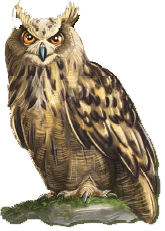
|
|
Place the game board
in the middle of the
table.
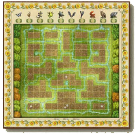
|
|
In a 3- or 4-player game: Each of you chooses a color and takes
the player board with a balloon of that color. Place it with the
balloon-side up in front of you.
|

|
In a 2-player game: One player takes both player boards with a white paraglider and the
other player takes both player boards with a black paraglider.
Place your two boards side by side in front of you to form your player board:

|
At Yucata.de the player colors are always assigned in the following order: 1. Orange, 2. Blue, 3. Black, 4. White. These player colors can be adjusted in the game options.
|
Each player: Cover each plant space on your player
board with a plant of that type and color. (You have
spaces of your own color and the neutral color.)
In 4-player games, leave spaces showing
the  -icon empty. -icon empty.
Return any spare plants to the box.
|

|
At Yucata.de, in order to save space, the player boards are displayed in a compressed manner:

|
Place the green joker marker onto the butterfly space on the left
side of the joker track.
There are 4 area spaces on the game board marked with clouds.
Place the shown number of cloud tokens onto each.
|
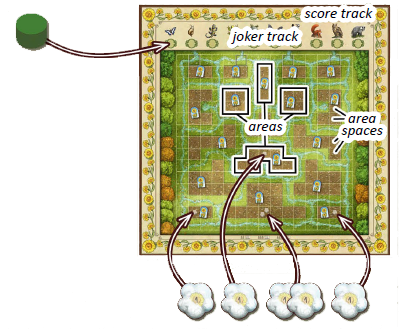
|
|
There are 18 areas on the game board, each with a
size number showing how many spaces are in it.
Shuffle the 21 area tokens face up and place one
into each area. Make sure that the main points
shown on each token matches the size number of
its area.
Return the 3 spare area tokens to the box
(without looking at their backs).
|
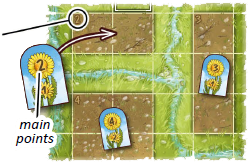
|
|
Each player: Place a cloud token onto each of the 6 cloud spaces on your player board.
Return any spares to the box.
|

|
|
Shuffle the 55 dominoes face down and deal them out as follows:
-
in a 4-player game, deal 13 to each player
-
in a 3-player game, deal 18 to each player
-
in a 2-player game, deal 26 to each player
Return any spares to the box (without looking at their fronts).
Each player: Without looking at them, place your dominoes face down beside your
player board as your reserve. Then draw 3 and stand them horizontally in front of
you, so that only you can see their fronts. These 3 dominoes form your hand.
|
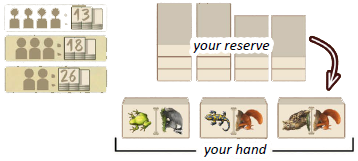
|
|
The player who last went for a walk in nature becomes the starting player and places the score marker
of their color onto space 4 of the score track. Going clockwise, the next player places their marker
onto space 3, the third player (if any) onto space 2 and the fourth player (if any) onto space 1.
|

|
The starting player begins the game by taking a turn. Then play proceeds clockwise with players taking one turn each until nobody
has any dominoes left and the game ends.
On your turn, carry out the following steps in this order:
|
A:
|

|
Place 1 domino from your hand onto the game board or return 1 to the box.
|
|
B:
|

|
If you placed a domino, you may place 1 plant onto a free area space beside it.
|
|
C:
|

|
-
If you placed a plant, score points for it.
-
Check if you triggered any area scorings.
|
|
D:
|

|
If possible, refill your hand with 1 domino from your reserve.
|
|
In addition, throughout your turn, you may spend cloud tokens to perform cloud actions.
|

Then it’s the player to your left’s turn.
|
A:
|

|
Place 1 domino from your hand onto the game board
|
Choose a domino from your hand and place it face up onto the game board:
|
Each of its two
halves must
cover a free
brook space.
It may not
protrude into
any area
or beyond
the grid.
|
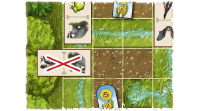
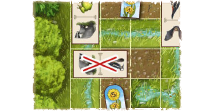
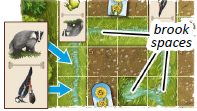
|
|
The joker marker shows the current joker animal. This animal can
be placed beside any animal and any animal can be placed beside
it. (At the start of the game, the butterfly is the joker animal. The
joker animal can be changed by a cloud action - see here).
|

|
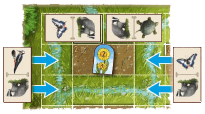
|
All animals beside each
other must match.
If there is even one
mismatch, you can not
place your domino
that way.
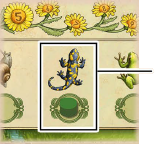
|
Example:
If the current joker animal is the
salamander, just these 2 dominoes
could go in the red frame.
|
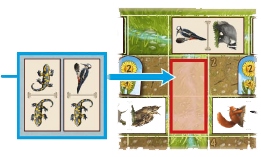
|
If you are unable to place a domino or do not want to, you must discard one to the box instead.
|
B:
|

|
Place 1 plant onto the game board
|
After placing a domino onto the game board, you may place a plant beside it:
|
Take any plant from your player board. Its type and color may affect
how many points you score in step C (see next section).
Place it onto a free area space beside the domino you just placed.
An area space is free if there is no plant on it.
|

|
If an area token is in the way when you place your plant, move the token to any free part of that area. (It will only be removed after
its area is scored - see step C.)
|
If you place your plant onto an area space that has any cloud tokens on it, place
them onto free cloud spaces on your player board. If you have no free cloud
spaces for them, either make room by immediately performing a cloud action or
return them unused to the box.
At Yucata.de you need to make room before taking the cloud tokens. Otherwise
the surplus cloud tokens are discarded. After taking the cloud tokens, there's no opportunity anymore to do a
cloud action in order to create the necessary space.
This has no effect on gameplay but simplifies the implementation.
Note: The faint point number on each cloud token serves as a reminder that at
the end of the game you gain 1 point for each cloud token on your player board
(see End of the game).
|
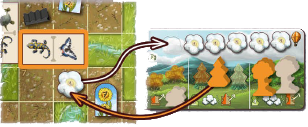
|
If there are no free area spaces beside your domino, you can not place a plant.
Note: At the end of the game, you’ll lose points for any plants left on your player
board (see End of the game). So don’t miss out on this step too often.
|
C:
|

|
Score points for your plant and check for area scorings
|
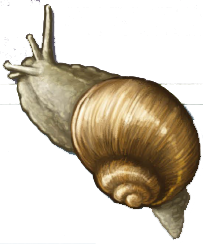 1) Points for your plant:
1) Points for your plant:
If you placed a plant in step B (of your color or neutral), score points for it now:
Gain 1 point for the plant itself and 1 point for each plant (of any color) in that area with equal or lower value.
The value of each plant is shown by its height:
turf  = Value 
|
bush  = Value 
|
pine  = Value 
|
oak  = Value 
|
|
Mark your points on the score track by moving your score marker forward accordingly.
(There can be several score markers on the same space.)
|

|
Example:
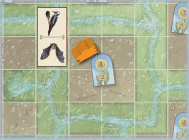
|
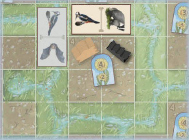
|
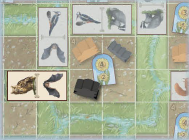
|
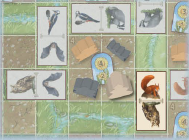
|
|
a) In an empty 4−space area,
Mary
places a bush and
scores 1 point.
|
b) Frank, on his turn, places a turf
in the same area and scores
1 point (he doesn’t score for
the orange bush since it is of a
higher value than his turf).
|
c) On a later turn, Frank places
a bush in the same area and
scores 3 points (1 for that
bush, 1 for the orange bush
and 1 for his turf).
|
d) On her next turn,
Mary
places a neutral pine in
that area and scores
4 points.
|
2) Check if any area scorings are triggered:
|
At the end of step C, check if your domino has closed off any areas.
An area is closed off if each of the brook spaces beside it is either:
-
covered by an animal or
-
isolated.
A brook space is isolated if there is no free brook space beside it
(which means it can never receive a domino).
Remember: Brook spaces that are diagonally adjacent to an area
are not beside that area. So the area can be closed off even if any of
them are free.
For each area that you closed off this turn, a separate area scoring is
triggered now:
To score an area, first calculate
each color’s total
value by summing
the values of its plants within the area.
Any colors whose total values are tied are treated as though they
are not present.
If nobody’s color is present, no points are scored.
Otherwise continue as follows:
|
If only one color is present and it belongs to a player
(i.e. isn’t neutral), that player scores both the main
and minor points shown on this area’s area token.
Otherwise, if the highest value is a player’s color, that
player scores the main points shown. If it’s neutral,
these points are not scored.
If the second-highest value is a player’s color, that
player scores the minor points shown. Again, if it’s
neutral, these points are not scored.
There are no points for third-, fourth- or fifth-highest
values.
|

|
|
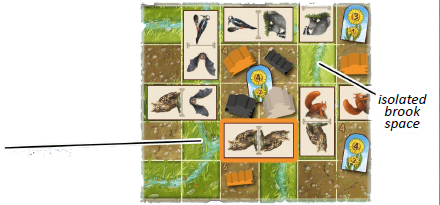
Example 1:
Mary
places the domino with the 2 owls and thereby
closes off a 4−space area. At the end of step C of her
turn, that area is scored:
-
Mary’s total value is  (1 bush) (1 bush)
-
Frank’s total value is
 (1 bush + 1 turf) (1 bush + 1 turf)
-
The total value of the neutral color
is also
 (1 pine) (1 pine)
Since black and
neutral
have the same total, they are
considered not present, which leaves
orange
as the
only color. Thus
Mary
scores 6 points (4 + 2).
Mary
gets the area token (because she was the one
who closed off the area).
|
|
Example 2:
Neutral
has the highest total ( ) and Frank has the
second highest ( ) and Frank has the
second highest ( ). Frank gains 2 points (the minor
number on the area token). ). Frank gains 2 points (the minor
number on the area token).
|
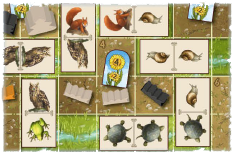
|
|
Finally, take the area token and place it face up
in front of you (because you were the one who
closed off its area).
Note: Each area token has a number of points faintly printed on its back.
These points will be awarded at the end of the game. You are allowed to
look at the backs of your own area tokens (gained by closing off areas)
but should keep them secret until the final scoring.
|

|
|
D:
|

|
Refill your hand
|
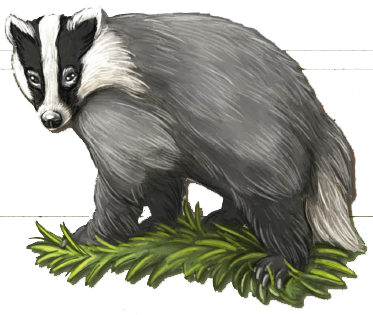 Refill your hand with a domino drawn from your reserve.
Then your turn ends.
Refill your hand with a domino drawn from your reserve.
Then your turn ends.
If your reserve is empty, skip this step and do not refill your hand for the
rest of the game.
|

|
Once you are out of dominoes, your turn is skipped for the rest of
the game. Players who still have dominoes continue taking their
turns as usual.
|
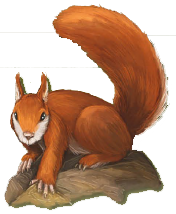 Cloud actions
Cloud actions
On your turn, in addition to steps A to D, you may perform any number of cloud actions.
Each cloud action costs cloud tokens, which you must return from your player board to the box.
There are 3 types of cloud action:
|

|
Change the joker animal
At any time in your turn, you may spend 2 cloud tokens to change
the current joker animal by moving the joker marker to any space on the joker track.
|

|
Take another turn
At the end of your turn, you may spend 3 cloud tokens to immediately take another turn.
You may take as many turns in a row as you can afford.
|
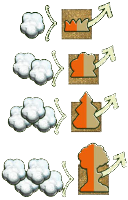
|
Return plants from the game board to your player board
At any time in your turn, you may spend cloud tokens to return a plant from the game board (even from a
closed-off area) to your player board:
For each plant that you return, you must spend a
number of cloud tokens equal to its value.
|
You can only return plants of your
own color or
the neutral color
. This can be any neutral plant
(irrespective of who placed it) but you must have a free
space of the right color and shape for it. (In a 4−player
game, plant spaces with the  -icon are not free.) -icon are not free.)
|
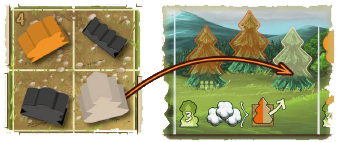
|
|
When everyone has run out of dominoes, the game ends.
Then carry out the final scoring as follows:
First, score any areas that still have area tokens. Go through them one by one. For each, carry out the area scoring as described in
the yellow-framed section, but return its area token to the box afterwards.
Once those areas have been scored, each player also scores as follows:
-
For each cloud token on your player board, gain 1 point
-
Lose points equal to the value of each plant
on your player board.
-
Finally, flip any area tokens you collected
and gain the points printed on their backs.
|
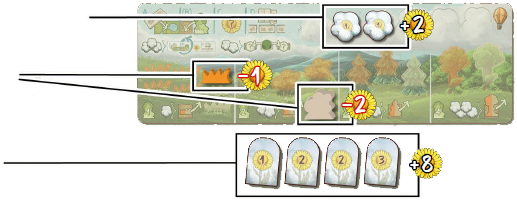
|
Once the final scoring is complete, the player with the most points wins. Ties are broken in favor of the player with more area
tokens. If still tied, the victory is shared.
|
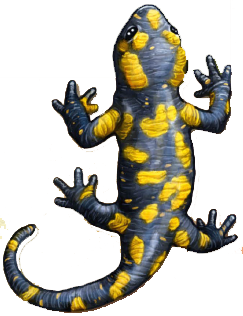 Play goes clockwise until nobody has any dominoes left.
Play goes clockwise until nobody has any dominoes left.
On your turn:
|
|
A:
|

|
Place 1 domino from your hand onto the game board or return 1 to the box.
|
see here
|
|
B:
|

|
If you placed a domino, you may place 1 plant onto a free area space beside it.
|
see here
|
|
C:
|

|
-
If you placed a plant, score points for it. (1 point for the plant itself + 1 point
for each plant of equal or lower value in that area).
-
If your domino closed off any areas, score them according to the
yellow-framed section. Afterwards, collect their area tokens
face up in front of you.
|
see here
|
|
D:
|

|
If possible, refill your hand with 1 domino from your reserve.
|
|
see here
|
|
Throughout your turn, you may spend cloud tokens to perform any number of cloud actions:
|
see here
|

|
Change the joker animal
|

|
Take another turn
|

|
Return plants of your color or the
neutral color to your player board
|
When your reserve of dominoes runs out, you do not refill your hand any more.
When your hand runs out, your turn is skipped for the rest of the game.
When no player has any dominoes left, the game ends.
Then carry out the final scoring:
-
score any areas that have not been closed off
-
gain 1 point per cloud token on your player board
-
for each plant on your player board, lose points equal to its value
-
reveal the points on the backs of your collected area tokens and score them
The player with the most points wins.
Something has changed in Renature valley: mushrooms are suddenly shooting up everywhere! And they completely change
the way the game is played. A mushroom allows areas to be connected and thus enlarged, even allowing another player to
take over an area! Transform the polluted valley back into an intact ecosystem, let the animals move in again, and plant in
adjacent areas to get points. Use the advantages that the mushrooms bring to expand individual areas with their help or
join areas occupied by other players.
While Renature is challenging, it gets even trickier in Renature Valley.
|
1 double-sided game board
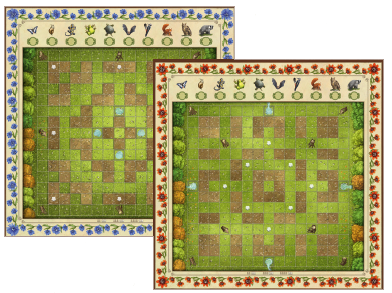
|
|
|
8 Mushroom tokens
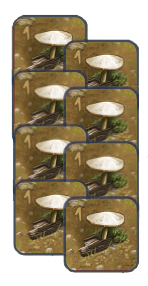
|
|
2 cloud tokens
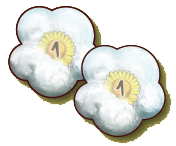
|
|
For this expansion you will need all the components from the Renature base game,
except for the 21 area tiles and the game board.
|
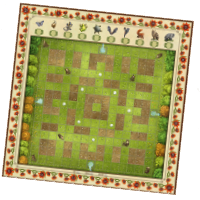 Prepare the game components as
in the original game. Replace the
game board from the base game
with the enclosed game board.
Place it face up in the middle of
the table.
Prepare the game components as
in the original game. Replace the
game board from the base game
with the enclosed game board.
Place it face up in the middle of
the table.
|
|
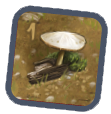 Instead of distributing the area
tiles, place the 8 mushroom tiles next to
the game board, with their brown side
facing up.
Instead of distributing the area
tiles, place the 8 mushroom tiles next to
the game board, with their brown side
facing up.
|
|
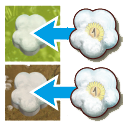 Add the two new Cloud tokens to the
other 30 and place 1 cloud token on
each cloud space.
Add the two new Cloud tokens to the
other 30 and place 1 cloud token on
each cloud space.
|
|
The remaining steps of the original setup remain the same.
|
The rules are the same as in the base game, with the following exceptions:
|
A:
|

|
Place 1 Domino on the board.
|
|
B:
|

|
Place 1 plant onto the game board.
|
|
C:
|

|
Score points for your plant.
|
|
D:
|

|
If possible, refill your hand with 1 domino from your reserve.
|
WHAT IS NEW?
|
A:
Place 1 Domino on the board
|
|
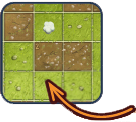
|
1. Meadow spaces
The new meadow spaces replace the stream spaces on which the dominoes are placed. The
rules for placing the dominoes have not changed.
|
|
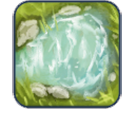
|
2. Starting spaces
In this expansion, the starting spaces are marked by a small pond. When you place a domino
from your hand, one of the animals depicted on it must be placed on one of the 4 starting
spaces or next to an animal of the same kind.
|
|
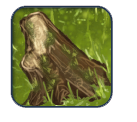
|
3. Tree Stumps
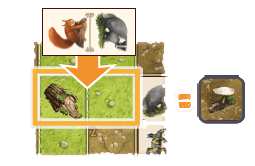 The 8 tree stumps on the game board are also new.
Whenever you cover a stump with a domino, you may immediately
take a mushroom token.
The 8 tree stumps on the game board are also new.
Whenever you cover a stump with a domino, you may immediately
take a mushroom token.
|
|
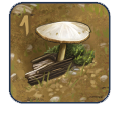
|
4. Mushrooms
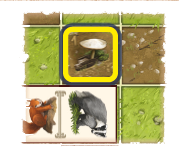 When you collect a mushroom by covering a stump, you must
immediately place it orthogonally (not diagonally) adjacent to
any area space. The mushroom becomes an area space, on which
plants can be placed, and which can join area spaces together.
When you collect a mushroom by covering a stump, you must
immediately place it orthogonally (not diagonally) adjacent to
any area space. The mushroom becomes an area space, on which
plants can be placed, and which can join area spaces together.
|
|
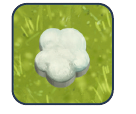
|
5. Meadow space with a cloud
If you want to place your domino on a meadow space with a cloud, first take the cloud tile on
it and place it on an empty cloud space on your player board. If you have no free cloud spaces,
either make room by immediately performing a cloud action, or return it unused to the box.
|

|
B:
Place 1 plant onto the game board
The rules for placing plants are the same as in the base game. Since mushroom tiles placed
on the game board count as area spaces, plants may also be placed on them according to the
rules of the base game.
|
|
C:
Score points for your plant
Follow the rules of the base game to earn points: Gain 1 point for the placed plant itself (regardless of whether it is
your color or the neutral color) and 1 point for each additional plant in that area with equal or lower value (regardless
of its color). The same rules apply to an area expanded by a mushroom tile as to all other area spaces.
|
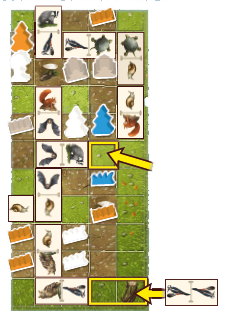
|
To cover the tree stump on the bottom
right, Orange places the
domino
with the two woodpeckers on the
game board and immediately receives
a
mushroom tile in return.
Orange plans to place this in such a
way that an area of 16 spaces is created
on the right edge of the fi eld.
|
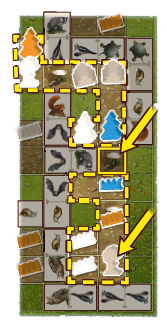
|
Orange now places the mushroom token
as planned. This connects 2 areas,
both of which were also formed of two
connected areas.
Finally, Orange places an
oak tree, gaining one point for that oak, and 10
for the plants in the area of equal or
lower value.
|
WHAT IS MISSING?
Scoring Areas
Areas are no longer scored when they are completed (step C.2) during the course of the game.
Thus, no scoring of plants takes place in closed areas.
|
D:
|
If possible, refill your hand with 1 domino from your reserve. Then your turn ends.
|
End of the game
When everyone has run out of dominoes, the game ends with the final scoring: first carry out the area scoring as
described in the original game.
To do this, check areas one by one and determine the total value for each color represented there. If there are multiple
colors with the same total value, these colors are ignored when scoring the area. The color with the highest total score
gets 1 point for each square in the scored area.
The color with the second highest total gets half the points (rounded down). If you are alone in an area, you get points
for the highest and second highest total value. Points are not awarded for the neutral color. After scoring an area, remove
all plants from it.

|
For each cloud token on your player board, gain 1 point.
|

|
Lose points equal to the value of each plant left on your player board.
|
As soon as the final scoring is over, whoever has the most points wins. Ties are broken in favor of the player with the
majority in the largest area.
VARIANT
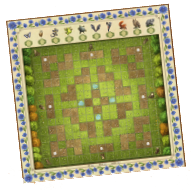
|
 In this variant, use the back side of the game board.
Cloud tokens are placed on the area spaces, as in the base game. You get the
cloud token by placing a plant on that area space. First, take the cloud token
from the space, and place it on an empty cloud space on your player board.
Otherwise play as in the base game.
In this variant, use the back side of the game board.
Cloud tokens are placed on the area spaces, as in the base game. You get the
cloud token by placing a plant on that area space. First, take the cloud token
from the space, and place it on an empty cloud space on your player board.
Otherwise play as in the base game.
|
-
You can activate the color blind help in the game settings.
-
Irrelevant animals on dominoes on the game board can be blinded out via the game settings. An animal on a domino is considered irrelevant if no domino can be placed adjacent to it. Beside the default setting ("Visible fainted") you may set the display these animals to be "Hidden" or "Fully visible" via the game settings.
-
For better contrast, already scored areas are displayed in a different color (dark green instead of brown). If you don't like this, you may disable it in the game settings.
-
The indication of joker animals on dominoes (on by default) can be turned off in the game settings.
-
Hovering with your mouse over an area token on the board will display information about the current total values of players' plants in that area. It also shows how many points the players will get when this area is scored, based on their current plants in the area. The point values of players whose plants have the same total value are displayed stroken through.
-
Hovering with your mouse over an area id or coordinate in the game log will highlight the corresponding area or field on the board, respectively.
-
Animations can be disabled via the game settings.
| |